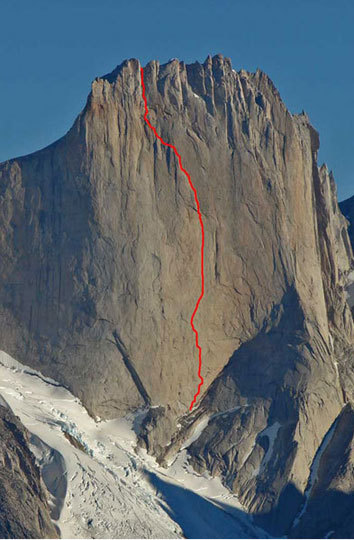
La Routa de l’Hermano (5.11a A3, 950m), established over 33 hours February 7-8 by Italians Herve Barmasse and Cristian Brenna. It is the first ascent of Cerro Piergiorgio’s (2719m) true northwest face, a conspicuous and oft-attempted wall above the upper Marconi Glacier, Patagonia, Argentina. [Photo] Ragni di Lecco
Herve Barmasse and Cristian Brenna have completed the somewhat overdue and much-coveted ascent of the true northwest face of Cerro Piergiorgio (2719m) above the upper Marconi Glacier, north of the Cerro Torre Group. On their final attempt, which took place over February 7-8, the two Italians established La Routa de l’Hermano (5.11a A3, 950m, Barmasse-Brenna, 2008) in a round trip of 33 hours from the rimaye at the base of the wall. Barmasse, who comes from a long line of celebrated guides living in the shadow of the Matterhorn, and Brenna, a 5.14c sport climber and former World Cup event winner who first visited the Greater Ranges in 2005, resulting in a very productive trip to the Chogolisa Glacier, Pakistan, combined their considerable talents to overcome a wall of largely poor granite in the short weather window available. Out of 1150 meters of climbing, the pair report only three pitches where the rock could be described as sound, and there was considerable objective danger. Much aid was needed on expanding flakes, in knifeblade cracks and across smooth walls, interspersed with only little bits of free climbing.
Attempts on this impressive face have predominately come from Italians, starting in 1984 when a team attempted the elegant pillar that forms the right edge. This was climbed the following year by Mario Manica and Renzo Vettori to give the excellent Greenpiece (5.10d A1, but now all free at 5.11d, 800m). Others came and went until 1995-1996 when eight Italians, including Mario Conti and Casimiro Ferrari, both of whom are now almost universally attributed with the first ascent of Cerro Torre, made a frontal attack, getting about 350 meters up a line in the center that led to the right side of a conspicuous flake-cum-tower high on the wall. At around the same time a small team comprising just Maurizio Giordani and Luca Maspes was forcing a more direct route to the left. Using fixed ropes, this pair reached a point about three-quarters of the way up the face before retreating (leaving their ropes in place for a future attempt). The incomplete route was named Gringos Locos (VII 5.11d A4, ca. 700m, 21 pitches). They came back next season but found the ropes shredded and not wishing to go through the whole process again made the first ascent of the northeast ridge. At the same time four French including Stephane Benoist made another attempt at the northwest face but bailed after only a hundred meters. Italians dal Pra, Girardi, Nadali and Sacchi climbed Pepe Rayo (VI 5.11d A3, 650m) to the summit ridge, but although this is an excellent climb in its own right, it was way over to the east, on the shorter wall round to the left of the true northwest face, and they stopped a long way from the summit.
In the intervening years there have been several other attempts, including one in 2002 by the German big wall climbers Berecz and Tivadar, which ended prematurely when their portaledge, placed at the bottom of the face, was ripped from the wall by high winds and blown 10 meters (with the occupants inside) onto the glacier. A 2003 Italian attempt failed to reach the high point on the Ferrari line, and in late 2005 a team including Barmasse and Maspes completed eleven pitches up the face, placing a number of fixed ropes more or less on the line of Gringos Locos, before Maspes was hit by rockfall; the climbers retreated.
So the inherent objective danger was known well to Barmasse and Mario Conti when they returned in 2008 to try to complete the Ferrari line. The fourth member of the team was Giovanni Ongaro. Unfortunately, the 2005 scenario repeated itself; only this time the victim was Ongaro, who had his hands broken by a huge block of falling ice. Getting him down from the wall was difficult, and then the team was faced with the long march back to Chalten. Conti volunteered to accompany Ongaro to the airport, while Barmasse and Brenna went back up for another attempt. After a dawn start the pair was hit by high winds in late afternoon and decided to retreat to the rimaye.
The weather looked better the following day, and they noticed three people walking at the base of the Marconi glacier, took this as a good sign, and decided to start early the following morning. In late afternoon on the 7th Conti arrived back at the camp in the rimaye, saw his friends high on the face, and radioed to tell them the weather forecast was bad. At this point there didn’t seem too far to go, so donning headtorches, Barmasse and Brenna continued the ascent and reached the top at 2 a.m. The way down went without much incident, the pair taking a break in a small niche they named the Condor’s Nest, waiting until dawn before finishing the descent.